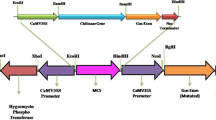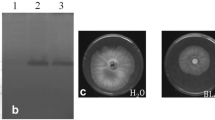Abstract
We have studied whether a chitinase involved in cell autolysis of a filamentous fungus,Rhizopus oligosporus, can operate as an antifungal defense system in tobacco. Thechi1 gene was introduced into tobacco by theAgrobacterium tumefaciens leaf disc system. Among 22 transgenic tobacco plants, 2 were selected and their individual homozygous progeny, Tch1-1 and Tch2-1, were studied. Chitinase activity in the extracts of young leaves from Tch1-1 or Tch2-1, in which thechi1 gene product was detected by Western blot analysis, was three- to four-fold higher than that from the control plants. A fungal infection assay on the leaves infected with the discomycete pathogensSclerotinia sclerotiorum andBotrytis cinerea revealed that the symptoms observed with these two were remarkably suppressed as compared with the control leaves.
Similar content being viewed by others
Abbreviations
- CaMV :
-
Cauliflower mosaic virus
- Km r :
-
kanamycin resistant
- Km s :
-
kanamycin sensitive
- MS :
-
Murashige and Skoog
- PCR :
-
polymerase chain reaction
- PDA :
-
potato dextrose agar
- PR :
-
pathogenesis-related
References
Bartnicki-Gatcia S, Lipman E (1972) The bursting tendency of hypal tips of fungi: presumptive evidence for a delicate balance between wall synthesis and wall lysis in apical growth. J Gen Microbiol 73:487–500
Blaiseau PL, Lafay JF (1992) Primary structure of a chitinase-encoding gene (chi1) from the filamentous fungusAphanocladium: similarity to bacterial chitinases. Gene 120:243–248
Broglie KE, Gaynor JJ, Broglie RM (1986) Ethylene-regulated gene expression: molecular cloning of the genes encoding an endochitinase fromPhaseolus vulgaris. Proc Natl Acad Sci USA 83:6820–6824
Broglie K, Chet I, Holliday M, Cressman R, Biddle P, Knowlton S, Mauvains CJ, Broglie R (1991) Transgenic plants with enhanced resistance to the fungal pathogenRhizoctonia solani. Science 254:1194–1197
De La Cruz J, Hidalgo-Gallego A, Lora JM, Benitez T, Pintor-Toro J, Llobell A (1992) Isolation and characterization of three chitinases fromTrichoderma harzianum. Eur J Biochem 206:859–867
Gaynor JJ (1988) Primary structure of an endochitinase mRNA fromSolanum tuberosum. Nucleic Acids Res 16:5210
Hayes CK, Klemsdal S, Lorito M, Pietro AD, Nakas JP, Tronsmo A, Harman GE (1994) Isolation and characterization of an endochitinase-encoding gene from a cDNA library ofTrichoderma harzianum. Gene 138:143–148
Horsch RB, Fry JE, Hoffmann NL, Eichholtz D, Rogers SG, Fraley RT (1985) A simple and general method for transferring genes into plants. Science 227:1229–1231
Jones JDG (1986) Isolation and characterization of genes encoding two chitinase enzymes fromSerratia marcescens. EMBO J 5:467–473
Jones JDG (1988) Expression of bacterial chitinase protein in tobacco leaves using two photosynthetic gene promoters. Mol Gen Genet 212:536–542
Kunz C, Sellam O, Bertheau Y (1992) Purification and characterization of a chitinase from hyperparasitic fungusAphanocladium album. Physiol Mol Plant Pathol 40:117–131
Mauch F, Staehelin LA (1989) Functional implications of the subcellular localization of ethylene-induced chitinase andβ-1,3-glucanase in bean leaves. Plant Cell 1:447–457
Mauch F, Hadwiger LA, Boller T (1984) Ethylene: symptom, not signal for the induction of chitinase andβ-1,3-glucanase in pea pods by pathogens and elicitors. Plant Physiol 76:607–611
Melchers LS, Sela-Buurlage MB, Ponstein AS, Bres-Vloemans SA, van den Elzen PJM, Cornelissen BJC (1993) Only specific tobacco (Nicotiana tabacum) chitinase andβ-1,3-glucanases exhibit antifungal activity. Plant Physiol 101:857–863
Metraux JP, Boller T (1986) Local and systemic induction of chitinase in cucumber plant in response to viral, bacterial and fungal infections. Physiol Mol Plant Pathol 28:161–169
Metraux JP, Streit L, Staub TH (1988) A pathogenesis-related protein in cucumber is a chitinase. Physiol Mol Plant Pathol 33:1–9
Murashige T, Skoog F (1962) A revised medium for rapid growth and bioassays with tobacco tissue cultures. Plant Physiol 15:473–497
Murray MG, Thompson WF (1980) Rapid isolation of high molecular weight plant DNA. Nucleic Acids Res 8:4321–4325
Neuhans JM (1991) High-level expression of a tobacco chitinase gene inNicotiana sylvestris susceptibility of transgenic plant toCercospora nicotianae infection. Plant Mol Biol 16:141–151
Nishizawa Y, Hibi T (1991) Rice chitinase gene: cDNA cloning and stress-induced expression. Plant Sci 76:211–218
Pegg GF, Young DH (1981) Changes in glycosidase activity and their relationship to fungal colonization during infection of tomato byVerticillium albo-atrum. Physiol Plant Pathol 19:371–382
Robert WK, Selitrennikoff CP (1988) Plant and bacterial chitinases differ in antifungal activity. J Gen Microbiol 134:169–176
Sambrook J, Fritsch EF, Maniatis T (1989) Molecular cloning: a laboratory manual, 2nd edn. Cold Spring Harbor Laboratory, Cold Spring Harbor, NY
Schlumbaum A, Mauch F, Vogeli U, Boller T (1986) Plant chitinases differ in antifungal activity. Nature 324:365–367
Sela-Buurlage MB, Ponstein AS, Bres-Vloemans SA, Melchers LS, van den Elen PJM, Cornellissen BJC (1993) Only specific tobacco (Nicotiana tabacum) chitinase andβ-1,3-glucanase exhibit antifungal activity. Plant Physiol 101:857–863
Shinishi H, Mohnen D, Meins F (1987) Regulation of a plant pathogenesis-related enzyme. Inhibition of chitinase and chitinase mRNA accumulation in cultured tobacco tissue by auxin and cytokinin. Proc Natl Acad Sci USA 84:89–93
Southern EM (1975) Detection of specific sequences among DNA fragments separated by gel electrophoresis. J Mol Biol 98:503–517
Suslow TV, Matsubara D, Jones J, Lee R, Dunsmuir P (1988) Effect of expression of bacterial chitinase on tobacco susceptibility to leaf brown spot. Phytopathology 78:1556
Yanai K, Tanaka N, Kojima N, Horiuchi H, Ohta A, Takagi M (1992) Purification of two chitinases fromRhizopus obligosporus and isolation and sequencing of the encoding genes. J Bacteriol 174:7398–7406
Author information
Authors and Affiliations
Additional information
Communicated by J. Widholm
Rights and permissions
About this article
Cite this article
Terakawa, T., Takaya, N., Horiuchi, H. et al. A fungal chitinase gene fromRhizopus oligosporus confers antifungal activity to transgenic tobacco. Plant Cell Reports 16, 439–443 (1997). https://doi.org/10.1007/BF01092762
Received:
Revised:
Accepted:
Issue Date:
DOI: https://doi.org/10.1007/BF01092762




